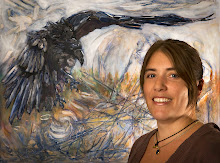I love to paint, and I like my paintings for the most part; but I wanted to discover a new subtlety to make it fresh and ultimately improve what I do. I just didn't know what that subtlety was. I came to study at the Florence Academy of Art because the school is renowned and one of the top 3 belle arte schools in Italy. It is based on the Academia tradition set up in Paris in the 1800's which in turn was a program designed to return to teaching the basic principals and ideals laid out in the Renaissance, which in turn was based on rediscovering the classical Greek art forms. It is a long and winding road working it's way back through the history of western art to antiquity.
I have heard that if you really want to understand something you need to start at the beginning. So that is what I am attempting to do. The beginning, going back to school, a school based on antiquity, ancient ideals and techniques. It is through this process that I have learned what it is I came here to learn. I wanted a subtlety, some little unknown trick that would open new doors for me. Well I have found it, and it was not so subtle when I discovered it, but more-so hit me in the head like a ten ton brick!
Through-out our studio time I have realized I did not come to Italy to learn how to paint. I already know how to paint. I have done it nearly every day of my life for the past 25 years. I have come to Italy to learn how to see. To see an object, a shape, a form, a colour, a nuance. If you can not see these then you can not paint them. I can still remember my older brother looking at one of my earliest paintings. I was about 10 and had received a set of acrylic paints for Christmas. I was trying to copy pictures of animals from National Geographic magazines. I showed my brother Greg what I had done. He has never been one to sugarcoat his answers. He said to me, "it's o.k. but you need to learn to paint what you see, not what you know." A somewhat profound discourse between a 15 year old and a ten year old, admittedly I didn't totally understand what he meant. Now I do. Learning to see means forgetting everything you know about the world around you and then breaking it down into abstract shapes and forms that relate to each other. Once you can do that, you are able to draw just a few shapes that fit together like puzzle pieces and when you stand back, look at them and realize you just drew a face, or a building or a bird's wing in flight. It really is quite a magical experience to stand back and be shocked by your own work. This happened to me when I stood back and realized I had painted my son's toy car, it looked as though I could reach over and pick it up off the canvas.
Perhaps some will say - "but what about the emotion, the feeling, the imagination and the abstract? You can not see these. What if you don't want to paint realism?" How true, I would compare this to a musician learning to hear. If you learn your scales, and are able to actually hear them recognizing notes, picking them out of an ensemble, knowing and hearing the differences from one semi-tone to another then you can improvise. You need to be able to hear the notes before you can change the nuances, add emotion and create a sound that follows it's own rules. It is the same in painting. I have no interest in being a realist painter when I finish here for my life is filled with reality enough; but I can hardly wait to see what compositions and nuances I will be able to compose with these new eyes and all that I can see!
Still life after six days of work
Still life after four days ( had to repaint the pepper twice...the first one rotted over the weekend and I couldn't find one the same shape!)
Still life after two days
It really could use a few more days work, but i have left it to continue on with the many other projects we are working on.
The Nose after 2 days in studio
The Nose after 4 days in studio
The Nose after 6 six days in studio






















